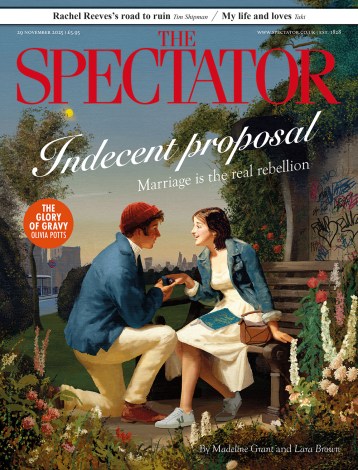One loom, six metres in length, currently dominates the great, light-filled weaving hall of Edinburgh’s renowned tapestry workshop, Dovecot Studios. At its side sits Master Weaver Naomi Robertson, threading yarn from countless dangling bobbins between and around taut vertical strings, each dabbed with tiny, code-like markings. The tapestry, which is growing slowly upwards from the base of the loom, forms a spread of pinks, reds and golds, shifting horizontally through rich tonal ranges. The subject is as yet unclear.
Given the intensity of the colour in this tapestry, it may seem surprising that its architect should be the painter Alison Watt, known for her bleached-out portraiture and paintings of white cloth. The tapestry is destined for the Theatre Royal in Glasgow where, at the behest of Scottish Opera, it will hang over three floors of a new extension due to open next summer. In commissioning this work, which will be the largest piece of public art at the theatre, Scottish Opera has satisfied a longstanding desire to work with both Dovecot and Alison Watt. It has also set in motion a lengthy and complex process of creative collaboration quite unlike any other.
When Watt was approached to design the tapestry for Scottish Opera, she naturally turned to painting to produce the initial image, which now stands beside the loom at Dovecot, dwarfed by the frame of the tapestry before it. The painting shows a folding length of fabric, patterned and richly coloured. A dark gorge cuts across the design sucking the eye into a deep, lightless chasm of the kind found so often in Watt’s work. Where this image differs is in the palette and the pattern, both inspired by Puccini’s Madame Butterfly. This was Scottish Opera’s inaugural performance and it will also be the first opera staged in the revamped theatre. It is, Watt says, an opera that ‘has such an impact upon the senses’. Her intention is to reflect something of the drama and atmosphere of the performance in the tapestry while referencing the opera’s oriental origins with a visual nod to the obi sashes of traditional Japanese dress.
The design is all about the colour and the chasm. The challenge for Naomi Robertson and her team at Dovecot Studios was to translate this painted vision into the medium of tapestry, a process that required months of discussion between painter and weaver about colour and technique. Days were spent examining samples in search of the appropriate hues while Robertson produced small-scale woven sections to experiment with the weaving approach. Key to the success of the final piece was finding a way to suggest the gradual tonal gradations of the painting, something that, unusually, requires the tapestry to be woven on its side to allow gentler transitions.
The weaving process is very different from painting, where colours are layered on top of one another to give the finished effect. Tapestry instead involves mixing hues on the same plane, with vibrancy coming from the colour selection of each thread on each bobbin and the visual effect given by these single colours lying against each other. A tapestry as large as this (it will measure 5.6 x 4.2 metres) will involve the use of hundreds of bobbins, each rolled with up to six strings of individually coloured yarn. It is the artful combination of these different hues that gives the weaver the precision necessary to manipulate the shift of colour and tone across the whole piece.
Behind the long loom holding the Watt tapestry are pinned large pieces of paper with map-like contours traced across them, the working drawings that guide the weaver. The lines important to the weaver’s eye are marked on the naked warp as well but, although everything has been preprepared with almost mathematical precision, the subtleties of tone and colour changes within these markings are seemingly made instinctively. The language of tapestry emphasises certain aspects of the original, and gives an added depth to the vibrancy as the wool absorbs as well as reflects the light that falls on each little woven lump across the surface. The result is something that will have solidity and richness, a unique tactile quality and a distinct visual thrum.
The conversion to tapestry is a process of translation and embellishment, rather than a reductive reproduction. Alison Watt calls it ‘a sort of alchemy’. An opulent symbol of art and craft combined, it is an appropriate artwork to hang on the wall of Scotland’s longest-running theatre. Scottish Opera describes Madame Butterfly as ‘painting beautifully exotic pictures in sound that are dramatic, often hauntingly lyrical, and full of emotion’. In commissioning this work it has acquired the reverse; a powerful visual interpretation of music, one, furthermore, which offers cultural continuity in the translation of sentiment from Puccini to Watt through the ancient language of the tapestry.






Comments